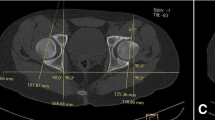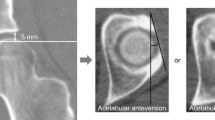Abstract
Background
Recent biplanar radiographic studies have demonstrated acetabular retroversion and increased superolateral femoral head coverage in hips with slipped capital femoral epiphysis (SCFE), seemingly divergent from earlier CT-based studies suggesting normal acetabular version.
Question/purposes
We therefore asked: Are there differences in (1) acetabular version at the superior ¼ of the acetabular dome (AVsup), (2) acetabular version at the center of the femoral head (AVcen), and (3) superolateral femoral head coverage (lateral center-edge angle [LCEA]) among affected SCFE hips, unaffected hips, and normal controls?
Methods
We identified 32 patients with SCFE who underwent CT between 2007 and 2012. Twenty-three met our inclusion criteria. Seventy-six age- and sex-matched normal patients comprised the control group. Pelvic rotation, tilt, and inclination were corrected on each CT. AVsup, AVcen, and LCEA were measured.
Results
The mean AVsup of the affected hips (−1.71°) demonstrated retroversion compared to the unaffected hips and the control group; the mean AVsup of the unaffected hips was similar to that of the normal controls. Mean AVcen was similar among the three groups. The LCEA was higher in affected and unaffected SCFE hips than in the control group (34.3° versus 34.5° versus 28.9°, respectively), but we found no difference between affected and unaffected hips.
Conclusions
Our data suggest an association of superior acetabular retroversion and increased superolateral femoral head coverage in SCFE. Whether this represents a primary abnormal morphology or a secondary pathologic response remains unclear. Further studies investigating the role of acetabular morphology in SCFE and its implications for development of symptomatic femoroacetabular impingement are warranted.



Similar content being viewed by others

References
Abel MF, Sutherland DH, Wenger DR, Mubarak SJ. Evaluation of CT scans and 3-D reformatted images for quantitative assessment of the hip. J Pediatr Orthop. 1994;14:48–53.
Anda S, Terjesen T, Kvistad KA. Computed tomography measurements of the acetabulum in adult dysplastic hips: which level is appropriate? Skeletal Radiol. 1991;20:267–271.
Buller LT, Rosneck J, Monaco FM, Butler R, Smith T, Barsoum WK. Relationship between proximal femoral and acetabular alignment in normal hip joints using 3-dimensional computed tomography. Am J Sports Med. 2012;40:367–375.
Chen L, Boonthathip M, Cardoso F, Clopton P, Resnick D. Acetabulum protrusio and center edge angle: new MR-imaging measurement criteria—a correlative study with measurement derived from conventional radiography. Skeletal Radiol. 2009;38:123–129.
Chung SM, Batterman SC, Brighton CT. Shear strength of the human femoral capital epiphyseal plate. J Bone Joint Surg Am. 1976;58:94–103.
Dandachli W, Ul Islam S, Tippett R, Hall-Craggs MA, Witt JD. Analysis of acetabular version in the native hip: comparison between 2D axial CT and 3D CT measurements. Skeletal Radiol. 2011;40:877–883.
Dodds MK, McCormack D, Mulhall KJ. Femoroacetabular impingement after slipped capital femoral epiphysis: does slip severity predict clinical symptoms? J Pediatr Orthop. 2009;29:535–539.
Fishkin Z, Armstrong DG, Shah H, Patra A, Mihalko WM. Proximal femoral physis shear in slipped capital femoral epiphysis—a finite element study. J Pediatr Orthop. 2006;26:291–294.
Fraitzl CR, Kafer W, Nelitz M, Reichel H. Radiological evidence of femoroacetabular impingement in mild slipped capital femoral epiphysis: a mean follow-up of 14.4 years after pinning in situ. J Bone Joint Surg Br. 2007;89:1592–1596.
Gelberman RH, Cohen MS, Shaw BA, Kasser JR, Griffin PP, Wilkinson RH. The association of femoral retroversion with slipped capital femoral epiphysis. J Bone Joint Surg Am. 1986;68:1000–1007.
Heyworth BE, Dolan MM, Nguyen JT, Chen NC, Kelly BT. Preoperative three-dimensional CT predicts intraoperative findings in hip arthroscopy. Clin Orthop Relat Res. 2012;470:1950–1957.
Hosalkar H, Pandya N, Bomar J, Wenger D. Hip impingement in slipped capital femoral epiphysis: a changing perspective. J Child Orthop. 2012;6:161–172.
Iglic A, Antolic V, Srakar F. Biomechanical analysis of various operative hip joint rotation center shifts. Arch Orthop Trauma Surg. 1993;112:124–126.
Jacquemier M, Jouve JL, Bollini G, Panuel M, Migliani R. Acetabular anteversion in children. J Pediatr Orthop. 1992;12:373–375.
Kitadai HK, Milani C, Nery CA, Filho JL. Wiberg’s center-edge angle in patients with slipped capital femoral epiphysis. J Pediatr Orthop. 1999;19:97–105.
Kordelle J, Richolt JA, Millis M, Jolesz FA, Kikinis R. Development of the acetabulum in patients with slipped capital femoral epiphysis: a three-dimensional analysis based on computed tomography. J Pediatr Orthop. 2001;21:174–178.
Larson AN, Yu EM, Melton LJ 3rd, Peterson HA, Stans AA. Incidence of slipped capital femoral epiphysis: a population-based study. J Pediatr Orthop B. 2010;19:9–12.
Leunig M, Casillas MM, Hamlet M, Hersche O, Notzli H, Slongo T, Ganz R. Slipped capital femoral epiphysis: early mechanical damage to the acetabular cartilage by a prominent femoral metaphysis. Acta Orthop Scand. 2000;71:370–375.
Li PL, Ganz R. Morphologic features of congenital acetabular dysplasia: one in six is retroverted. Clin Orthop Relat Res. 2003;416:245–253.
Loder RT. The demographics of slipped capital femoral epiphysis: an international multicenter study. Clin Orthop Relat Res. 1996;322:8–27.
Loder RT. Controversies in slipped capital femoral epiphysis. Orthop Clin North Am. 2006;37:211–221, vii.
Loder RT, Richards BS, Shapiro PS, Reznick LR, Aronson DD. Acute slipped capital femoral epiphysis: the importance of physeal stability. J Bone Joint Surg Am. 1993;75:1134–1140.
Mamisch TC, Kim YJ, Richolt JA, Millis MB, Kordelle J. Femoral morphology due to impingement influences the range of motion in slipped capital femoral epiphysis. Clin Orthop Relat Res. 2009;467:692–698.
Manoff EM, Banffy MB, Winell JJ. Relationship between body mass index and slipped capital femoral epiphysis. J Pediatr Orthop. 2005;25:744–746.
Mavcic B, Pompe B, Antolic V, Daniel M, Iglic A, Kralj-Iglic V. Mathematical estimation of stress distribution in normal and dysplastic human hips. J Orthop Res. 2002;20:1025–1030.
Monazzam S, Bomar JD, Cidambi K, Kruk P, Hosalkar H. Lateral Center-edge Angle on Conventional Radiography and Computed Tomography. Clin Orthop Relat Res. 2012 October 16 [Epub ahead of print].
Pritchett JW, Perdue KD. Mechanical factors in slipped capital femoral epiphysis. J Pediatr Orthop. 1988;8:385–388.
Rab GT. The geometry of slipped capital femoral epiphysis: implications for movement, impingement, and corrective osteotomy. J Pediatr Orthop. 1999;19:419–424.
Reynolds D, Lucas J, Klaue K. Retroversion of the acetabulum: a cause of hip pain. J Bone Joint Surg Br. 1999;81:281–288.
Sankar WN, Brighton BK, Kim YJ, Millis MB. Acetabular morphology in slipped capital femoral epiphysis. J Pediatr Orthop. 2011;31:254–258.
Siebenrock KA, Kalbermatten DF, Ganz R. Effect of pelvic tilt on acetabular retroversion: a study of pelves from cadavers. Clin Orthop Relat Res. 2003;407:241–248.
Siebenrock KA, Schoeniger R, Ganz R. Anterior femoro-acetabular impingement due to acetabular retroversion: treatment with periacetabular osteotomy. J Bone Joint Surg Am. 2003;85:278–286.
Smith-Petersen MN. Treatment of malum coxae senilis, old slipped upper femoral epiphysis, intrapelvic protrusion of the acetabulum, and coxa plana by means of acetabuloplasty. J Bone Joint Surg. 1936;18:869–880.
Stanitski CL, Woo R, Stanitski DF. Acetabular version in slipped capital femoral epiphysis: a prospective study. J Pediatr Orthop B. 1996;5:77–79.
Tjoumakaris FP, Wallach DM, Davidson RS. Subtrochanteric osteotomy effectively treats femoroacetabular impingement after slipped capital femoral epiphysis. Clin Orthop Relat Res. 2007;464:230–237.
Visser JD. Functional treatment of congenital dislocation of the hip. Acta Orthop Scand Suppl. 1984;206:1–109.
Weiner D. Pathogenesis of slipped capital femoral epiphysis: current concepts. J Pediatr Orthop B. 1996;5:67–73.
Zupanc O, Krizancic M, Daniel M, Mavcic B, Antolic V, Iglic A, Kralj-Iglic V. Shear stress in epiphyseal growth plate is a risk factor for slipped capital femoral epiphysis. J Pediatr Orthop. 2008;28:444–451.
Author information
Authors and Affiliations
Corresponding author
Additional information
Each author certifies that he or she, or a member of his or her immediate family, has no funding or commercial associations (eg, consultancies, stock ownership, equity interest, patent/licensing arrangements, etc) that might pose a conflict of interest in connection with the submitted article.
All ICMJE Conflict of Interest Forms for authors and Clinical Orthopaedics and Related Research editors and board members are on file with the publication and can be viewed on request.
Each author certifies that his or her institution approved the human protocol for this investigation, that all investigations were conducted in conformity with ethical principles of research, and that informed consent for participation in the study was obtained.
About this article
Cite this article
Monazzam, S., Krishnamoorthy, V., Bittersohl, B. et al. Is the Acetabulum Retroverted in Slipped Capital Femoral Epiphysis?. Clin Orthop Relat Res 471, 2145–2150 (2013). https://doi.org/10.1007/s11999-012-2697-5
Published:
Issue Date:
DOI: https://doi.org/10.1007/s11999-012-2697-5



